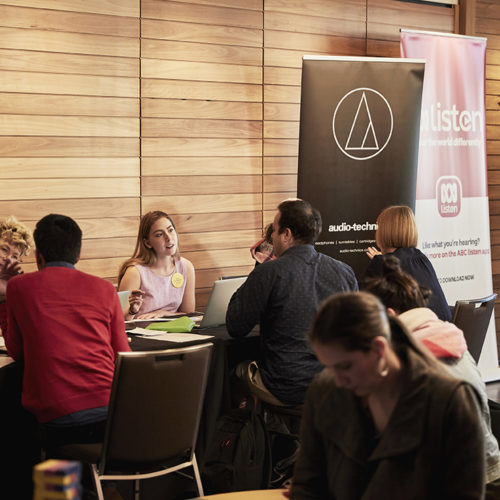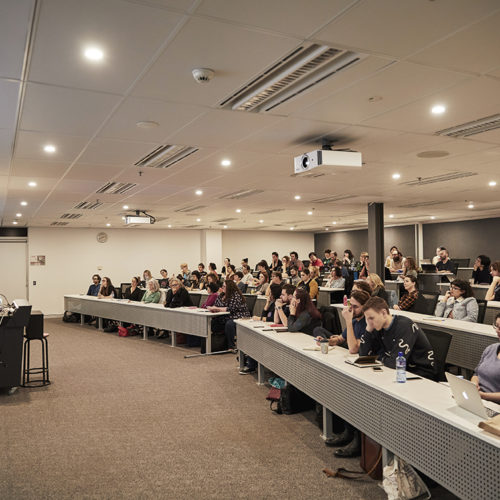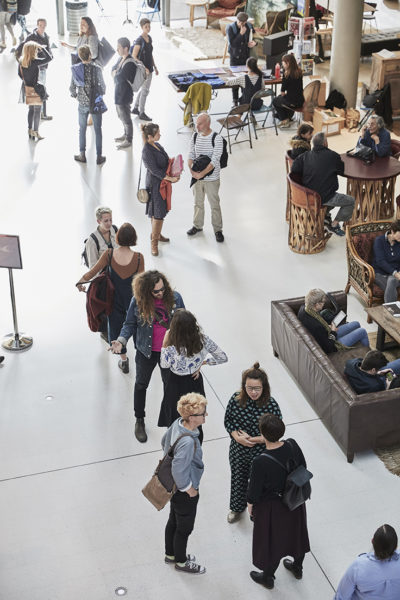First-timer (and Audiocraft Regional Travel Fund recipient) Ben Tupas (Last Will and Testament) and conference regular Lindsey Green (People Movers) report from Audiocraft Podcast Festival 2018. Writing for the Australian Audio Guide, they reflect on what they learned about Australian identity, ambition and independence.

Ben Tupas: If finding your podcasting tribe means travelling from regional Queensland to Sydney, then that’s what I did.
When Audiocraft did a call-out for regional producers to apply for their Regional Travel Fund in April, I came good on a pact that I had made with myself at the beginning of this year – to take up every opportunity to develop my craft, and connect with producers outside the confines of Toowoomba, my current base.
Fast forward to June, and I was doing everything in my power to not get caught sneaking long, wide-eyed stares up the tall buildings around UTS, the site of Day One of the conference – like some over-sensitised country kid.
Lindsey Green: I look forward to the Audiocraft line-up the way others wait for music festivals. I diligently pore over producer bios and fill my podcast feed with their work, preparing myself for the likely situation that I’ll meet some of them.
Since its first year at 107 Projects in Redfern, Audiocraft has grown not only in physical size, but participant numbers and international guests.
I look forward to the Audiocraft line-up the way others wait for music festivals.
The 2016 line-up included Timothy Nicastri, Miyuki Jokiranta, Bec Fary, Jon Tjhia, Joel Werner, Tiger Webb, Jaye Kranz, Sophie Townsend, Giordana Caputo, Kween G, Maddy Macfarlane, Gavin Ivey and Sherre Delys.
International guests: zero.
In 2017, there were three international guests: Megan Tan (USA), Caitlin Thompson (USA) and Eric Nuzum (USA).
This year, there were seven: Jesse Baker (USA), Collin Campbell (USA), Michelle Macklem (CAN), Helen Zaltzman (UK), Eleanor McDowall (UK), Katie Rogers (UK) and Robert Smith (CAN/USA).
Seeing international producers on the line-up is exciting. ‘They’re coming all this way just for us?’ I think. It’s strange to think of podcast people as celebrities, but that’s how it feels to read their names on the long-awaited line-up and to see and hear them in real life. And like with any kind of celebrity, it can be easy to get swept away with the spectacle.
Money talks
BT: NPR’s Robert Smith led the international guest list with a session that gave the packed room fantastic insight into producing the show, Planet Money.
A caveat: I’m a big NPR fan and more generally, I obsess over behind-the-scenes insight on craft, expertise – and, well, techy stuff. And as with Smith’s entertaining economics podcast, I walked away with new ideas about the economies of scale that come with producing such a popular show.

Take for example, the team of 11 (!) people who work on rolling out two episodes per week; the fact that only 10% of stories pitched are actually approved for production; and that part of their winning storytelling formula is starting big and then going small in terms of the approach and angle.
LG: Smith discussed how he constructs a Planet Money story, including: making abstract concepts appear real, finding little stories inside big ideas, making a map of your ideal story and signposting it accordingly, creating human moments in interviews, and finally, ‘remember[ing] why you used to love the story’.
Planet Money is one of my favourite podcasts and Smith is one of my favourite hosts. It was hard to not feel a little enamoured of someone I admire so much, even if his advice was not directly applicable to my career stage or resources.
BT: Having worked previously with the national broadcaster, where I felt a journalistic style and voice permeated through even the most personal of stories, it was refreshing to remember that there is a place for artful audio, too.

Know your worth
LG: As Smith spoke, and I increasingly felt as if my work would never be as good as Planet Money, I thought of Johanna Bell’s presentation earlier in the day – at a session called ‘Searching for the Australian Sound’. In it, Bell described Australians’ tendency towards self-deprecation. She explained how tall poppy syndrome lures us into believing that our stories are not worth telling.
Like a lot of people, I look up to American podcasts and producers. I subconsciously and self-consciously think they’re the best. This is not only unfair, but incorrect.
Two of my favourite pieces of radio are Kirsti Melville’s ‘The Storm’ and Jaye Kranz’s ‘Easy Love’. All The Best release consistently high quality episodes every week, Troll Foods was exceptional, Broadwave is innovative. Every other episode in my podcast feed is from the ABC. The list goes on.
It took listening to Robert Smith, alongside Australian producers I admire in equal measure, to remind me that I needn’t always look to the States for high quality, creative audio. The idea that Australian stories aren’t worth telling became less and less convincing as the Festival continued – and I listened to, spoke to and learned from more local producers.
The idea that Australian stories aren’t worth telling became less and less convincing as the Festival continued.
Further education
BT: Jon Tjhia (Paper Radio) talked about keeping it simple and acting on instinct while comparing his approach to storytelling to the dance and movement artform.
And during the Sunday workshops at the Australian Film, Television and Radio School (AFTRS), Eleanor McDowall (Radio Atlas) deconstructed her layered soundscapes for the session ‘Visceral Audio’, and spoke about the ambiguity of sounds. McDowall imparted that as creators we don’t always have to tell the audience how to feel while playing audio-rich grabs from stories about wrestling and, er – squirting.

Both these sessions reminded me to take a more cinematic approach to the recording, editing and mixing processes. I came away thinking about how I can capture a continuum of sound – from a macro, wide-angle view to a micro, intimate audio close-up.
And seeing a Pro Tools session screenshot from Unravel – via sound engineer Martin Peralta (Trace) – hammered home that being organised, especially when cutting tape in a team, is key.
LG: Love and Luck producer Erin Kyan’s words resonated when he offered that he’d ‘rather be happy making garbage, than miserable making a masterpiece’.
Kyan and co-producer Lee Davis-Thalbourne walked us through every step of making Love and Luck – from pre-production through to recording, editing, publishing and marketing. Spreadsheets and file management aren’t the most exciting parts of podcast production, but for independent producers, they can be crucial for keeping a project on track.
With new episodes released every Tuesday, Love and Luck is an ambitious podcast. Kyan and Davis-Thalbourne approach it pragmatically. In their presentation, they discussed the importance of measuring their expectations against their individual capacity – like time, skills and money.
While there are certainly challenges to producing a podcast independently, an advantage is the ability to carve out a niche for yourself and your audience. ‘We hope that straight people enjoy it, but we didn’t make it for them,’ Kyan said.

Natural connection
BT: The access, attention to detail and ‘finding your tribe’ moments of Audiocraft still stick with me months on.
I don’t know anywhere else where I’ll have the high-adrenaline experience of speed-pitching to Eric Nuzum (Audible) and a room bursting with ideas and intelligence, or sitting with the festival’s graphic designer Elin Matilda Andersson and braining out the visual identity for my own podcast (Last Will and Testament, currently in pre-production).
LG: I believe the social impact of creating work, and connecting with a community of like-minded people, is more important than how many people listen or how many times your work is downloaded. This kind of freedom is afforded to independent producers like myself – but not to those working for national public broadcasters like Smith.
Podcasts like Planet Money got me into podcasting. But events like Audiocraft, which present your idols as accessible and their talent as achievable, keep me going.
BT: Back home in Toowoomba after my short domestic flight, I padded back to my car through the gravel car park, my ears attuned to sound.
In terms of atmospheric noise, the contrast with Sydney was striking, and that difference stuck with me. There are many contexts, voices, stories and audiences across this country. As audio producers, our challenge is to understand and reflect the complexity of the land we share – and to bridge the distances, literal and otherwise, that separate us.
A fresh season of the Audiocraft Podcast has just launched, featuring sessions from this year’s Festival – such as those mentioned in this story – as well as bonus sessions from Chicago’s Third Coast International Audio Festival.